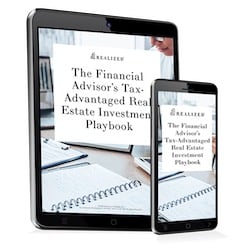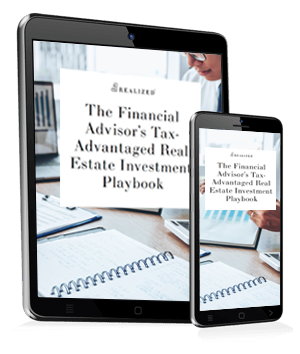
There are many different ways your clients can potentially benefit from including commercial real estate in their investment portfolios.
Real estate investors enjoy a host of tax advantages that come with owning and operating investment properties that can reduce their exposure to taxation by reducing their total reportable income. Investors also may enjoy stable cash flows from monthly rental payments, as well as asset appreciation.
Rest assured, you won’t have to advise clients who want to own commerical real estate (CRE) that they’ll have to become landlords. Passive real estate investments mean your clients won’t ever have to fix a clogged toilet or interact with tenants. Although some passive real estate investments don’t offer the tax advantages associated with direct property ownership, they still may be viable investment options for clients seeking exposure to CRE.
Let’s take a look at some of the ways your clients can get into passive real estate investing and the potential benefits they may enjoy. Lastly, we’ll discuss the importance of creating an overarching plan since investing in real estate can bring on additional risk.
How to Add Passive Real Estate Into Your Clients’ Portfolios
There are two primary ways your clients can be involved with real estate investment properties: Passive and active ownership (though you also can blend the two: active ownership with ongoing passive property management).
Active owners work in the weeds with their tenants by taking a “hands-on” role in the management and operation of their investment properties. Responsibilities may include property maintenance and repairs, lease negotiations, tenant relations, marketing, bookkeeping, and other duties required to manage the property and strive for tenant satisfaction. A few of the more active property ownership strategies include fixing and flipping rental homes, or buying dated C-class apartment properties in an attempt to increase asset value through targeted renovations, improved management, and operational synergies among similar properties in an owner’s portfolio.
Passive investing in real estate is a strictly “hands-off” approach – your clients have very little, if any, involvement in the property. In essence, you are handing off management duties to someone else while still enjoying the potential benefits associated with real property ownership.
Here are three common forms of passive real estate investing. Each has its own unique benefits and drawbacks.
- REITs. Real estate investment trusts, or REITs, are public or private companies that typically own a wide range of commercial real estate properties. The majority of REITs are publicly traded, allowing everyday investors the opportunity to participate in CRE assets that would be well beyond their financial means as solo investors. According to the National Association of Real Estate Investment Trusts, publicly traded REITs own more than $3 trillion of commercial assets in the U.S. Many REITs focus on one particular sub-sector of CRE, such as hospitality, senior housing, multifamily, or industrial. REIT shareholders receive dividend-based income and annual returns from properties held within the REIT, when applicable, without the hassles associated with direct property ownership. REITs are the most liquid of passive CRE investments; however they also are the most correlated to broader movements in the stock market. REITs also have limits on their tax benefits.
- DSTs. DSTs, or Delaware Statutory Trusts, are formed by real estate companies that identify and acquire the assets to be placed under trust. Individual investors purchase fractional shares of the DST until investor capital replaces equity capital put up by the sponsor to acquire the target properties. The IRS treats beneficial interests in a DST as direct property ownership, making DSTs eligible for 1031 exchanges and other tax sheltering. One potential disadvantage of DSTs, though, is that they are highly illiquid – DSTs have an average hold period between seven and 10 years.
- Crowdfunding. Real estate crowdfunding is a relatively new entry into passive property ownership. Real estate crowdfunding is done through online fundraising platforms that pair property owners and developers with retail and accredited investors. Investors pool their money, which provides working capital for commercial or residential property owners for renovations or acquisitions. Crowdfunding provides a low barrier to entry into CRE investments, but it does not offer the same tax advantages as other passive commercial real estate investments. For instance, crowdfunding investors aren’t 1031 exchange eligible, which exposes them to potential capital gains tax liabilities upon exit.
Now that we’ve identified the primary ways your clients can dip their toes into passive real estate investing, let’s take a look at some of the potential benefits that may result from this method of property ownership.
Benefits of passive real estate investing
Passive real estate ownership can come with many potential benefits. Among them:
- Lower barrier to entry. Retail investors may lack the financial wherewithal to purchase multi-million-dollar commercial investment properties. Some crowdfunding platforms let these investors enter into passive investments with as little as a few hundred or a few thousand dollars. Publicly traded REITs, meanwhile, may have a purchase price as low as one share.
- Time. Passive property owners aren’t involved in the day-to-day affairs of property management, which frees up a great deal of time for other endeavors.
- Expertise. Passive owners can lean on the expertise of REITs, DST sponsors, and crowdfunding sites to handle the intricacies of property management, asset acquisition, due diligence, and other areas that often require specialized knowledge of markets, property types, real estate law, taxation, finance, and other important elements of property ownership.
Putting it all Together
Passive property ownership has the potential to provide your clients with steady streams of income from sources that require little more than their investment capital. However, because these types of investments may bring about increased risk, it’s important to create an investment strategy that suits each client’s needs and objectives.
The passive real estate investments highlighted above, all have vastly different investment criteria. Initial client discussions should center around their financial goals and tolerance for risk since those two elements will help you craft individualized investment plans that align with their objectives, comfort level, and liquidity needs. These investments also can come with a host of unique tax concerns, so there are tax planning and strategies they’ll need to account for as well.
Your clients won’t have any control over their passive real estate investments, but at the same time, these investments don’t require them to put up millions of investment capital or have decades of experience as landlords. With proper planning and due diligence, you can help your clients add passive real estate investments to their portfolios while attempting to manage their exposure to risk.
Full disclosure. The information provided here is not investment, tax or financial advice. You should consult with a licensed professional for advice concerning your specific situation.



